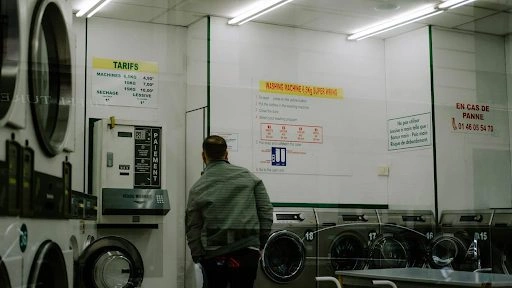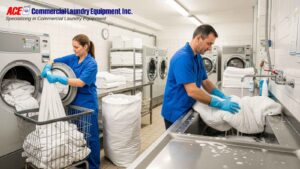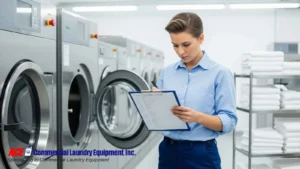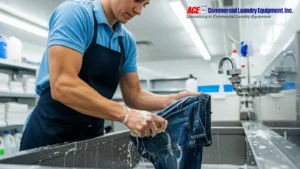Keeping commercial laundry machines running smoothly isn’t just about fixing them when they break down; it’s about proactive maintenance to extend their lifespan and maximize their efficiency. Properly maintained laundry equipment can significantly reduce operational costs and improve service quality. This comprehensive guide offers detailed strategies to maintain your commercial laundry machines, ensuring they continue to function effectively and last longer.
Understanding Your Commercial Laundry Equipment
Commercial laundry machines differ significantly from household appliances. They are designed to handle heavy workloads, continuous operation, and varying fabric types. Knowing how these machines operate and their specific maintenance needs is the first step to ensuring their longevity and optimal performance.
Types of Machines and Their Basic Needs
Different types of commercial laundry equipment have distinct roles and maintenance requirements. Understanding these needs is essential for effective care:
Washing Machines:
- Clean the detergent tray regularly to prevent clogs.
- Inspect and replace worn hoses to avoid leaks.
- Maintain balanced drum alignment to prevent vibration damage.
Dryers:
- Remove lint from filters daily to maintain airflow.
- Clean exhaust systems periodically to prevent blockages.
- Inspect belts and motors to ensure they operate smoothly.
Flatwork Ironers and Folders:
- Regularly lubricate moving parts for consistent performance.
- Clean heating elements to maintain even temperatures.
- Check electrical components for stability and functionality.
Importance of Regular Maintenance
Routine maintenance is critical for avoiding breakdowns and keeping machines running smoothly. Ignoring maintenance can lead to performance issues, safety risks, and high repair costs. Key advantages of maintenance include:
- Improved energy efficiency.
- Reduced downtime and repair expenses.
- Prolonged equipment lifespan.
- Safer operation for staff and customers.
1. Routine Cleaning and Inspection
Cleaning and inspecting your machines on a regular schedule keeps them running efficiently and identifies potential issues before they become major problems. Consistent upkeep is key to maintaining performance and minimizing downtime.
Daily, Weekly, and Monthly Cleaning Tasks
Establishing a cleaning routine ensures your machines remain in optimal condition. Daily cleaning tasks focus on removing debris and maintaining machine surfaces, while weekly and monthly tasks address deeper cleaning needs. For example, cleaning lint traps daily prevents dryer inefficiencies, while monthly descaling ensures washing machine performance. Following a schedule tailored to your machines’ usage can significantly improve their longevity.
Inspecting Components for Early Signs of Wear
Routine inspections are just as important as cleaning. Regularly checking for wear and tear on critical components, such as belts, hoses, and seals, allows you to address issues before they escalate. Unusual noises, leaks, or performance inconsistencies are signs that components may need attention.
2. Key Component Care
Proper care for critical machine components ensures they operate efficiently and reliably. Neglecting these parts can lead to frequent breakdowns and costly repairs.
Importance of Using High-Quality Replacement Parts
Using high-quality replacement laundry machine parts is essential for maintaining machine performance. Generic or low-cost parts may not fit properly or withstand heavy use, leading to premature failure. Investing in OEM (Original Equipment Manufacturer) parts ensures compatibility and durability, helping your machines perform like new after repairs.
Regular Checks and Replacement of Critical Components
Proactive replacement of components like belts, filters, and bearings based on their expected lifespan prevents unexpected breakdowns. Scheduling these replacements during routine maintenance minimizes downtime and avoids operational disruptions.
3. Optimizing Machine Use and Operation
Proper usage and operation play a significant role in preventing damage and extending the lifespan of your machines. Training staff and implementing best practices can drastically reduce wear and tear.
Training Staff on Proper Usage
Ensuring that staff members understand how to operate the machines correctly is crucial. Proper training includes instructions on loading limits, cycle settings, and routine cleaning tasks. Well-trained staff can identify and report potential issues early, ensuring timely repairs and maintenance.
Loading Techniques to Prevent Overuse and Damage
Overloading machines is a common cause of damage in commercial settings. Proper loading techniques, such as evenly distributing laundry and adhering to weight limits, prevent unnecessary strain on machine components and reduce the risk of malfunctions.
4. Environmental and Installation Factors
The environment where your machines operate and how they are installed can greatly impact their performance and durability. Taking these factors into account ensures your equipment operates in optimal conditions.
Choosing the Right Environment for Your Machines
Placing machines in well-ventilated areas with stable temperatures helps prevent overheating and corrosion. Proper drainage and humidity control also protect machines from water-related damage, ensuring reliable operation.
Adjusting Installation to Avoid Common Pitfalls
Correct installation of machines, including proper leveling and secure connections, reduces unnecessary vibrations and wear. Professional installation ensures that all components function as intended, minimizing the risk of early failures.
5. Leveraging Technology for Maintenance
Modern technology offers innovative solutions for maintaining commercial laundry equipment. Staying informed about advancements can help streamline maintenance processes and reduce costs.
Technological Advancements in Equipment Maintenance
Emerging technologies make equipment maintenance more efficient and accurate. These advancements include:
- Remote Monitoring: Enables real-time tracking of machine performance.
- Predictive Maintenance Systems: Identify potential issues before they lead to breakdowns.
- Automated Cleaning Cycles: Simplify daily maintenance tasks.
Benefits of Implementing Machine Health Tracking Systems
Machine health tracking systems provide detailed insights into the condition of your equipment, helping you prioritize maintenance tasks and reduce downtime. Benefits include:
- Early detection of performance issues.
- Reduced maintenance costs through optimized scheduling.
- Improved operational efficiency with less downtime.
6. Professional Maintenance and Servicing
While routine cleaning and basic maintenance are essential for keeping commercial laundry machines in good condition, some issues require the expertise of a professional. Professional servicing ensures that your equipment is inspected thoroughly, repaired correctly, and optimized for peak performance. Regular professional care can also extend the lifespan of your machines, reduce downtime, and prevent costly breakdowns.
When to Call in the Professionals
Not all maintenance tasks can be handled in-house. Certain commercial laundry repair and inspection requires specialized tools, technical knowledge, or experience to be done safely and effectively. Knowing when to involve professionals can save time, money, and unnecessary wear on your machines.
Situations that typically require professional servicing include:
- Diagnosing Electrical Faults: Electrical problems can pose serious safety risks and should only be addressed by certified technicians.
- Repairing Major Mechanical Failures: Broken drum bearings, motor issues, or heating element failures require tools and expertise not typically available to in-house staff.
- Annual Deep Cleaning and Descaling: Over time, mineral deposits and residue can accumulate in washing machines and dryers. Professionals have the equipment and chemicals needed to clean these deposits safely and effectively.
- Replacement of Critical Components: Parts like heating elements, belts, and motors are integral to machine operation. Replacing these components incorrectly can lead to further damage or inefficiencies.
- Calibration of Machine Settings: Professionals can adjust your machines’ settings to ensure they are running efficiently and according to manufacturer specifications.
Professional technicians are trained to identify potential issues that may not be obvious during routine checks, making their involvement crucial for maintaining the health of your machines.
Establishing a Servicing Schedule Based on Usage
The frequency of professional servicing depends on how heavily your machines are used. High-traffic laundromats or industrial facilities with continuous operation may require more frequent inspections and servicing, while machines with lighter workloads can be serviced less often. A tailored servicing schedule ensures that each machine receives the attention it needs without unnecessary downtime.
For example:
- Heavy Use Machines: Machines that operate for several hours daily, such as those in laundromats or hospitals, may require quarterly professional servicing. This includes deep cleaning, descaling, and component replacements as needed.
- Moderate Use Machines: Machines in facilities with moderate traffic, like smaller hotels, may only need biannual servicing to maintain optimal performance.
- Light Use Machines: Machines in settings with occasional use, such as small offices or community centers, may require annual servicing.
A consistent servicing schedule prevents small issues from developing into significant problems. It also ensures your equipment operates efficiently, reducing energy consumption and improving customer satisfaction.
In addition to regular servicing, keep a log of past repairs and inspections. This record helps technicians identify recurring issues and adjust maintenance plans accordingly. By combining routine maintenance with professional expertise, you can protect your investment and ensure reliable performance for years to come.
Protect Your Investment with Consistent Maintenance
Maintaining your commercial laundry machines is essential for ensuring reliable performance, extending their lifespan, and reducing operating costs. By following a regular maintenance schedule, training staff, and leveraging modern technology, you can keep your equipment in top condition. For businesses seeking reliable solutions, ACE Laundry Commercial Equipment offers high-quality machines and expert services to support your operations. Contact us today to learn more and protect your investment!




